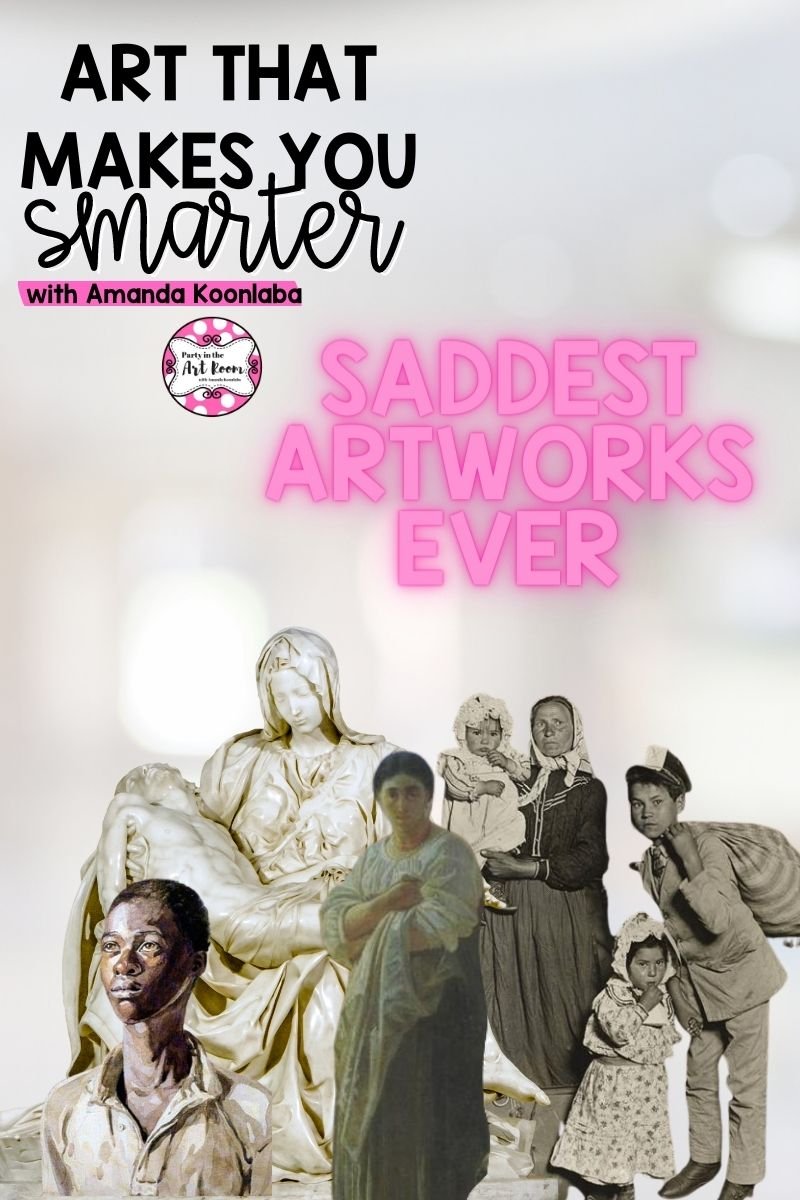5 Artworks That Will Break Your Heart
Any art lover will argue that a main purpose of art is to evoke emotions. This is especially true for visual art. Of course, there are many other significant roles of art. However, you’ll always remember how an artwork makes you feel.
The artworks I’m sharing today aren’t all rainbows and sunshine. These are magnificent pieces that broke me. Wrecked me! There are great opportunities with these works to evoke empathy in your students - a fantastic way to teach your students about social, political, and cultural issues.
These are hard images to look at, but they're significant because they matter. These images are powerful, and reflecting on them can make us better people.
Here are the artworks that nearly broke my spirit:
#1 The Pietà by Michelangelo (1499)
This is an iconic artwork! Italian sculptor Michelangelo made this piece in Florence. The sculpture is currently at St. Peter's Basilica in Vatican City.
This sculpture depicts Mary holding Christ after he died on the cross. You don't have to be a Christian or religious to relate to this work. It's a mother holding her deceased child.
People adore the sculpture for different reasons. I’m drawn by the mother’s pain. Even before knew I wanted to have children, I could relate to it. Here's a mother holding her son because he has been persecuted and murdered. There's a pain in her face. She has a look of resignation that saddens me.
If you take away the divine from this, this is a depiction of maternal hurt. The main thing about Mary in this work is the folds of her body. It almost looks like this body is about to absorb that child of hers back into the womb. It's remarkable!
This sculpture brings me joy because I love how he depicted Mary as a mother and not just a religious figure.
#2 Mother at the funeral of her child by Nikolai Nikolaevich Ge (1858)
The Russian painter created this artwork of a mother grieving the loss of her child. There's nobody with her. The painting is loneliness personified. The loss is written all over her face.
The lighting in this painting strikes me quite a bit because the left-hand side is very bright compared to the right-hand side. It gets darker where the mother stands. It’s like she's turning away from the light. And it looks like she's about to move into the dark.
I think it's because everybody else has moved on from the death of her child, and she hasn't. I imagine she might be feeling alone. The image itself is powerful, and it just breaks me.
She seems broken. Much like Mary, she seems resigned to her grief. It’s a very lonely painting.
#3 The immigrant family in the baggage room of Ellis Island by Lewis Hine (1905)
This photograph is probably from a period where many immigrants arrived. This art style is social realism, capturing the real.
I don't have all the context behind this image by Lewis Hine. But I don't need context to identify with it. The older woman looks worn out. She looks like she has worked hard her entire life.
They look like they don't have a lot of money. This family doesn’t have many possessions. The mom looks like she's weary, but she has smile lines. So, maybe this was a joyful woman dealt a difficult hand. I can't imagine what it must have been like to put everything you own in a sack, get on a boat, and go to a new country. My heart breaks when I think about that.
#4 Nat Turner by William H. Johnson (1945)
Nat Turner was an enslaved preacher who led a revolt in Virginia in 1831. It resulted in the deaths of 55 to 65 people. At least 51 of those people were white.
White people in Virginia formed militias and retaliated against the enslaved. It was mass murder! Turner could read and write, and this made him a leader. After the rebellion, Nat Turner hid for weeks.
When the militia found him, they hanged him. The white militia dismembered his body. As if that was not cruel enough, they made purses and other items out of his skin and sold them as souvenirs. We’re talking about someone’s child here, someone’s brother, a human being! Looking at this painting breaks me.
This painting is a documentation of our cruel history. If William H. Johnson had not depicted this, we would know Nat Turner and his work because we don’t learn about him in school. This is an opportunity to educate your students about Nat Turner’s life.
#5 No work by George Pemba (1948)
I was moved by this artwork. It made me think of the Great Depression. In the painting, we see an African American male. There are white people in the background who look like they’re living it up.
Perhaps there's supposed to be a contrast between the affluent white people and the young black guy that doesn’t have work. He’s not a part of whatever's happening.
In 1948, he probably couldn’t get a job at any of those places in the background, which is beyond sad. There’s a light on his face. He is looking up at the light like he has hope. He’s looking up as if to say he has not been broken.
All these works have historical, cultural, and social references. You can use them in your classrooms. Of course, you need to know which artworks are appropriate for your students, based on their age group and curriculum. I hope this will inspire you to research some of the art. I hope it inspires a lesson or two about some of these issues.





